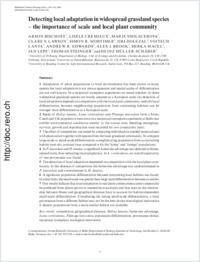Detecting local adaptation in widespread grassland species – the importance of scale and local plant community
- Bischoff, Armin University of Fribourg, Department of Biology, Unit of Ecology and Evolution, Switzerland
- Crémieux, Lisèle University of Fribourg, Department of Biology, Unit of Ecology and Evolution, Switzerland
- Šmilauerova, Marie University of South Bohemia, Branisovska, Ceske Budejovice, Czech Republic
- Lawson, Clare S. University of Reading, Centre for Agri-Environmental Research, Earley Gate, Reading, UK
- Mortimer, Simon R. University of Reading, Centre for Agri-Environmental Research, Earley Gate, Reading, UK
- Doležal, Jiří University of South Bohemia, Branisovska, Ceske Budejovice, Czech Republic
- Lanta, Vojtěch University of South Bohemia, Branisovska, Ceske Budejovice, Czech Republic
- Edwards, Andrew R. University of Reading, Centre for Agri-Environmental Research, Earley Gate, Reading, UK
- Brook, Alex J. University of Reading, Centre for Agri-Environmental Research, Earley Gate, Reading, UK
- Macel, Mirka University of Fribourg, Department of Biology, Unit of Ecology and Evolution, Switzerland
- Lepš, Jan University of South Bohemia, Branisovska, Ceske Budejovice, Czech Republic
- Steinger, Thomas University of Fribourg, Department of Biology, Unit of Ecology and Evolution, Switzerland
- Müller-Schärer, Heinz University of Fribourg, Department of Biology, Unit of Ecology and Evolution, Switzerland
-
2006
Published in:
- Journal of Ecology. - 2006, vol. 94, p. 1130-1142
Competition
Geographical distance
Holcus lanatus
Home-site advantage
Lotus corniculatus
Plantago lanceolata
Population differentiation
Provenance choice
Reciprocal transplant
Ecological restoration
English
1 Adaptation of plant populations to local environments has been shown in many species but local adaptation is not always apparent and spatial scales of differentiation are not well known. In a reciprocal transplant experiment we tested whether: (i) three widespread grassland species are locally adapted at a European scale; (ii) detection of local adaptation depends on competition with the local plant community; and (iii) local differentiation between neighbouring populations from contrasting habitats can be stronger than differentiation at a European scale.2 Seeds of Holcus lanatus, Lotus corniculatus and Plantago lanceolata from a Swiss, Czech and UK population were sown in a reciprocal transplant experiment at fields that exhibit environmental conditions similar to the source sites. Seedling emergence, survival, growth and reproduction were recorded for two consecutive years.3 The effect of competition was tested by comparing individuals in weeded monocultures with plants sown together with species from the local grassland community. To compare large-scale vs. small-scale differentiation, a neighbouring population from a contrasting habitat (wet-dry contrast) was compared with the 'home' and 'foreign' populations.4 In P. lanceolata and H. lanatus, a significant home-site advantage was detected in fitness-related traits, thus indicating local adaptation. In L. corniculatus, an overall superiority of one provenance was found.5 The detection of local adaptation depended on competition with the local plant community. In the absence of competition the home-site advantage was underestimated in P. lanceolata and overestimated in H. lanatus.6 A significant population differentiation between contrasting local habitats was found. In some traits, this small-scale was greater than large-scale differentiation between countries.7 Our results indicate that local adaptation in real plant communities cannot necessarily be predicted from plants grown in weeded monocultures and that tests on the relationship between fitness and geographical distance have to account for habitat-dependent small-scale differentiation. Considering the strong small-scale differentiation, a local provenance from a different habitat may not be the best choice in ecological restoration if distant populations from a more similar habitat are available.
- Faculty
- Faculté des sciences et de médecine
- Department
- Département de Biologie
- Language
-
- English
- Classification
- Botany
- License
- License undefined
- Identifiers
-
- RERO DOC 6060
- DOI 10.1111/j.1365-2745.2006.01174.x
- Persistent URL
- https://folia.unifr.ch/unifr/documents/300073
Statistics
Document views: 185
File downloads:
- mullerschaerer_dla.pdf: 211
